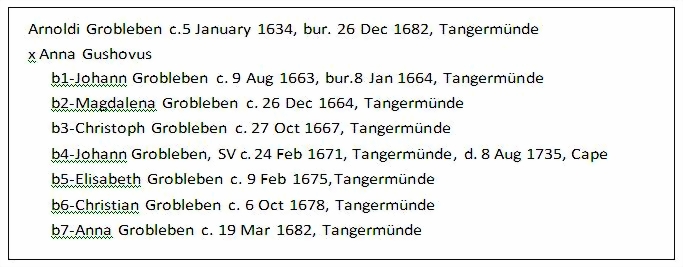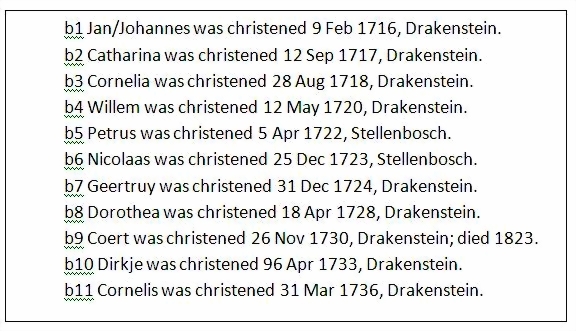GROBLER Johan
Stamvader Johan GROBLER (GROBBELAAR) was born 10 0ctober 1678 in Tangermünde, a town 100 km west from Berlin, Germany. He came to South Africa in about 1708. He was then in the service of the VOC and was employed as a woodcutter and later as a transport driver. We find him in 1712 in the service of Christiaan Maasdorp as a farm labourer. He became a free burger in 1715 and in the same year he married Geertruyd KNOESEN who was baptised on 11 July 1706 daughter of stamvader Cornelis Knoetzen and Dirkje Helms. On 3 June 1736 Geertruyd married stamvader Jan Jurgen Herman (also known as Hans Jurgen Herman(n) from Stuttgart), two months and 3 days after the birth of her youngest son - eleventh child Cornelis Grobler.
CHILDREN
b1 Johannes baptised Drakenstein 9 Feb 1716, X Drakenstein 16 Jul 1740 Margaretha Pyl wid of Jan Swanepoel
b2 Catharina baptised Drakenstein 12 Sep 1717, X Johannes Knoetzen
b3 Cornelia baptised Drakenstein 28 Aug 1718
b4 Willem baptised Drakenstein 12 May 1720, X Drakenstein 16 May 1756 Susanna Knoetzen
b5 Petrus baptised 5 Apr 1722, X Drakenstein 14 Feb 1751 Maryna Susanna Human
b6 Nicolaas baptised Stellenbosch 25 Dec 1723, X Drakenstein 15 Apr 1753 Johanna Hendrina Combrink
b7 Geertruy baptised Drakenstein 31 Dec 1724, X Cornelis van Niekerk, XX Drakenstein 3 Dec 1752 Christiaan Rabie
b8 Dorothea baptised Drakenstein 18 Apr 1728, X 19 Nov 1752 Michael Combrink
b9 Coert baptised Drakenstein 26 Nov 1730, X Tulbagh 29 Feb 1754 Maria Catharina Klopper, XX Tulbagh 1 May 1768 Louisa Pienaar
b10 Dirkje baptised 6 Apr 1733, X 10 March 1754 Cornelis Brits
b11 Cornelis baptised 31 March 1736, X 15 Aug 1762 Magdalena Elizabeth Volschenk
Sources:
J A Heese/R T J Lombard, South African Genealogies
Thanks to research by:
Thanks to submission by:
Mark Barker mabarker@mweb.co.za
Bron: Die Vroeë geslagte Grobbelaars van Cyferfontein, Distrik Bethulie, in die Suid-Oos Vrystaat 1861-1939 - PM Grobbelaar: Proefskrif 2008
"In die monsterrolle en die opgaafrolle word sy plek van herkoms aangegee as Tangermünde. Sy naam verskyn glad nie in die doopregister van die Parogiekerk te Tangermünde nie, nie as Jan of as Johan(n) Grobler nie.
Die naam van 'n sekere Christiaan Grobler wat op 10 Oktober 1678 daar gebore is, kom wel voor. Sy vader se naam was Arnold. Die naam van sy moeder word nie genoem nie. Hy was die enigste seun wat in die tydperk tussen 1617 en 1800 daar gebore is. Tussen 1642 en 1800 is daar ook geen Grobler in Tangermünde oorlede nie. 'n Huweliks- of sterftesertifikaat van Christiaan kon ook nêrens gevind word nie.
Hoewel hy dus daar gebore is, blyk dit dat hy nie in Tangermünde gewoon het nie. Dit is onwaarskynlik dat Jan en Christiaan een en dieselfde persoon is.
Volgens wyle dr. CL Grobler, in lewe 'n mediese praktisyn op Potchefstroom, is dit moontlik dat Jan uit 'n ander dorp afkomstig was en slegs vir 'n kort tydperk in Tangermünde gewerk het. Vandaar die waarskynlikheid dat hy hierdie stad as sy laaste woonplek aangegee het. Dit is bewys dat emigrante dikwels by die plek van herkoms wat die monsterrolle noem, nie hulle geboorteplekke aangedui het nie, maar wel die laaste woon- of werkplek voordat hulle in diens van die VOC getree het. Wyle dr. Eduan Grobbelaar, gedurende die sewentigerjare van die 20ste eeu kulturele attaché verbonde aan die Suid-Afrikaanse Ambassade in Bonn, het tydens 'n gesprek oor die familie genoem dat hy in 'n klein stadjie Tangerhütte, ongeveer 17 km van Tangermünde, sewe Groblers in die telefoongids getel het. Op grond hiervan is die profiel van Jan Grobler aangepas en is van die standpunt uitgegaan dat die eintlike plek van herkoms in 'n gebied met 'n straal van tussen 17 en 20 km om Tangermünde geleë moet wees. Tangerhütte is ongeveer 17 km van Tangermünde geleë en lê aan die Tangerrivier wat by Tangermünde met die Elbe saamvloei. Ingevolge die profiel van Jan Grobler moes hy tussen 23 en 33 jaar oud gewees het toe hy in 1708 aan die Kaap geland het.
Jan Grobler gaan in 1707 as soldaat aan boord van die skip vir sy reis na die Kaap. Dit was 'n moeilike en uiters vermoeiende reis, soos wat Otto Menzel, wat ook as soldaat na die Kaap gekom het, grafies die verloop en ontberings daaraan verbonde beskryf het".
Aangehaal op SAGen deur Simon du Plooy.
I note in your update note to the Grobler entry the following:
Dit is bewys dat emigrante dikwels by die plek van herkoms wat die monsterrolle noem, nie hulle geboorteplekke aangedui het nie, maar wel die laaste woon- of werkplek voordat hulle in diens van die VOC getree het.
That is a theory I have often seen put forward but no-one has yet, at least to my knowledge, provided any proof of that theory.
The VOC used place of birth as one of the identifiers (ids if you like) of their employees - some may well have deliberately falsified that information but most will simply have given their birth place.
If you look at the various documents in the council of Justice series where people are asked to provide details it is their place of birth they are asked for.
Likewise in the marriage registers though many entries simply say van ... it is the birthplace that is intended - which can be gauged from other clerks who wrote it out in full - geboortig van.
If anyone has the 'bewys' of the assertion above I would be very glad to see it, please.
Thanks,
Richard Ball
Norfolk, England
Johann Grobleben - Progenitor of the Grobler/Grobbelaar Families in South Africa
The progenitor of the Grobler/Grobbelaar families in South Africa was Johann Grobleben, christened on 24 February 1671 in Tangermünde, Germany. He was identified by a review of the Tangermünde church books. He was an elder brother of Christiaan Grobler who had historically been purported as the progenitor as Christiaan is the only person whose surname is clearly Grobler in the baptismal records. Keys in finding the progenitor were to match the name of Christiaan’s father Arnoldi with other birth records, and to recognise that the surnames in the other birth records were not Grobler but some variations of Grobleben. The rest of his immediate family are as follows:
The origin of Grobleben and hence Grobler is the small town Grobleben which is about 6 km WSW of Tangermünde. Grobleben means “the legacy of Grob”. It is not known who the original Grob was who would have lived in the 10th century when Tangermünde and presumably Grobleben were founded. The earliest record of Grobleben as a surname date from 1279 for Dominus Johann Grobleben who he was knight (dominus is a Latin title meaning master, lord, head). It was a common practice in the Middle Ages to adopt a place name as a surname, and many people from the same place ended up with the same surname, although they are not related. This can explain why the Groblers in Germany do not appear to be related to the South African Groblers.
Johann Grobleben’s genetic origin is West Slavic as most of the South African Groblers belong to haplogroup R‑L260 which is prominent in the West Slavic countries of Poland, Slovakia, and Czech Republic. The assimilation of Slavic tribes into Germanic tribes during the eastward expansion of Germanic tribes (from west of the Elbe river) into historic Slavic lands (east of the Elbe river) during the Middle Ages can explain his West Slavic genetic heritage. Based on the proximity of Tangermünde to the former Slavic Sorb territory and the high incidence of the R‑L260 haplogroup in the remaining Sorb population in Lusatia, it is likely that Johann Grobleben’s distant ancestors were Sorbs.
He joined the VOC as a soldier in 1705, and they registered him as Jan Groeplaar in the ledger of the ship Hof van Ilpendam which sailed out from Texel on 10 May 1705. A travel diary kept on board the ship by François Valentyn (published in a compendium Oud en Nieuw Oostindiën) provides some details of the voyage. They arrived in Table Bay on 29 September 1705, and he disembarked for duty at the Cape of Good Hope on 24 October 1705 with 16 of his mates. He was the only one out of a crew of 203 that remained in the Cape and became a free burgher farmer.
In the Cape of Good Hope his name became Jan Grobbelaar in the church records and some contracts, although he signed his own name as Jan Grobler throughout his life. His whereabouts from 24 October 1705 to the end of 1707 are not known. From 1708 to 1712 he was a woodcutter. By the end of 1709, his debts incurred for his passage from Europe to the Cape were settled. In 1713 he became a wagon driver at Groote Schuur. From August 1713 he was “on loan” as a farm hand to Christiaan Maasdorp and probably worked on Maasdorp’s two smallholdings on the Liesbeeck river. On 29 January 1715 he became a free burgher. He received payment against his credit balance with the VOC after 19 February 1715. He married Gertruida Knoetzen in April or May 1715. She was the daughter of Cornelis Knoetzen - from Funen Island in Denmark - and Dirkje Helms, and she was christened in the French church in Drakenstein on 2 Nov 1697. They had the following children
The children Jan and Willem did not leave descendants. The descendants of Petrus and Nicolaas generally carry the surname Grobler, while the descendants of Coert and Cornelis generally carry the surname Grobbelaar. There are minor variations like Grobelaar and Grobbler. Most Groblers and Grobbelaars are Afrikaans speaking, but there are some English speaking Groblers and Grobbelaars as well.
From 1716 he farmed, but it is not known where - until 4 February 1726 when he bought the farm Landskroon in Drakenstein where they farmed until he died on 8 August 1735. His son Cornelis was born posthumously and thus never knew his father. His wife Gertruida remarried Hans Jurgen Hermann on 3 June 1736. She had two more children, the last one born in 1738. The next transfer of the farm took place on 16 February 1742 to Pieter de Villiers (b2), and the farm is still in the De Villiers family today.
For questions or comments, please contact me via email at jan[@]grobbelaar.us
- Hits: 29402


